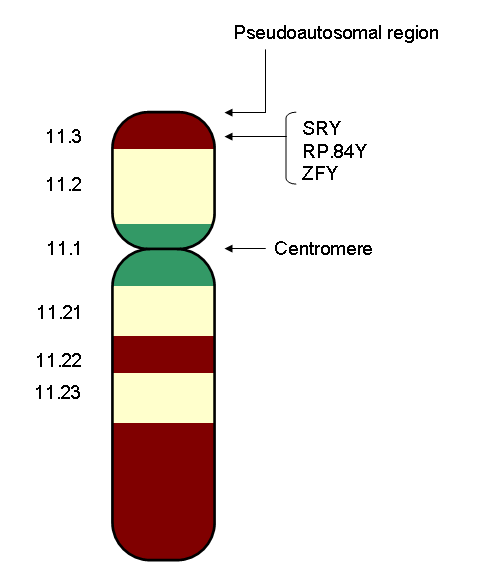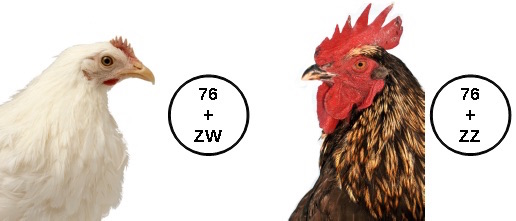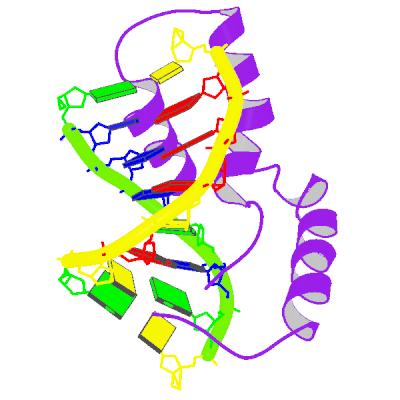|
Sexual Differentiation
Sexual differentiation is the process of development of the sex differences between males and females from an undifferentiated zygote. Sex differentiation is usually distinct from sex determination; sex determination is the designation of the development stage towards either male or female, while sex differentiation is the pathway towards the development of the phenotype. In many species, testicular or ovarian differentiation begins with the appearance of Sertoli cells in males and granulosa cells in females. As embryos develop into mature adults, sex differences develop at many levels, including chromosomes, gonads, hormones, and anatomy. Beginning with determining sex by genetic and/or environmental factors, humans and other organisms proceed towards different differentiation pathways as they grow and develop. Sex determination systems Humans, many mammals, and some insects and other animals have an XY sex-determination system. Humans have 46 chromosomes, including two sex ... [...More Info...] [...Related Items...] OR: [Wikipedia] [Google] [Baidu] |
Male
Male (Planet symbols, symbol: ♂) is the sex of an organism that produces the gamete (sex cell) known as sperm, which fuses with the larger female gamete, or Egg cell, ovum, in the process of fertilisation. A male organism cannot sexual reproduction, reproduce sexually without access to at least one ovum from a female, but some organisms can reproduce both sexually and Asexual reproduction, asexually. Most male mammals, including male humans, have a Y chromosome, which codes for the production of larger amounts of testosterone to develop male reproductive organs. In humans, the word ''male'' can also be used to refer to gender, in the social sense of gender role or gender identity. Overview The existence of separate sexes has evolved independently at different times and in different lineage (evolution), lineages, an example of convergent evolution. The repeated pattern is sexual reproduction in isogamy, isogamous species with two or more mating types with gametes of identic ... [...More Info...] [...Related Items...] OR: [Wikipedia] [Google] [Baidu] |
Y Chromosome
The Y chromosome is one of two sex chromosomes in therian mammals and other organisms. Along with the X chromosome, it is part of the XY sex-determination system, in which the Y is the sex-determining chromosome because the presence of the Y chromosome causes offspring produced in sexual reproduction to be of male sex. In mammals, the Y chromosome contains the SRY gene, which triggers development of male gonads. The Y chromosome is passed only from male parents to male offspring. Overview Discovery The Y chromosome was identified as a sex-determining chromosome by Nettie Stevens at Bryn Mawr College in 1905 during a study of the mealworm ''Tenebrio molitor''. Edmund Beecher Wilson independently discovered the same mechanisms the same year, working with Hemiptera. Stevens proposed that chromosomes always existed in pairs and that the smaller chromosome (now labelled "Y") was the pair of the X chromosome discovered in 1890 by Hermann Henking. She realized that th ... [...More Info...] [...Related Items...] OR: [Wikipedia] [Google] [Baidu] |
Gestation
Gestation is the period of development during the carrying of an embryo, and later fetus, inside viviparous animals (the embryo develops within the parent). It is typical for mammals, but also occurs for some non-mammals. Mammals during pregnancy can have one or more gestations at the same time, for example in a multiple birth. The time interval of a gestation is called the '' gestation period''. In obstetrics, '' gestational age'' refers to the time since the onset of the last menses, which on average is fertilization age plus two weeks. Mammals In mammals, pregnancy begins when a zygote (fertilized ovum) implants in the female's uterus and ends once the fetus leaves the uterus during labor or an abortion (whether induced or spontaneous). Humans In humans, pregnancy can be defined clinically, biochemically or biologically. Clinically, pregnancy starts from first day of the mother's last period. Biochemically, pregnancy starts when a woman's human chorionic gonado ... [...More Info...] [...Related Items...] OR: [Wikipedia] [Google] [Baidu] |
Hermaphrodite
A hermaphrodite () is a sexually reproducing organism that produces both male and female gametes. Animal species in which individuals are either male or female are gonochoric, which is the opposite of hermaphroditic. The individuals of many taxonomic groups of animals, primarily invertebrates, are hermaphrodites, capable of producing viable gametes of both sexes. In the great majority of tunicates, mollusks, and earthworms, hermaphroditism is a normal condition, enabling a form of sexual reproduction in which either partner can act as the female or male. Hermaphroditism is also found in some fish species, but is rare in other vertebrate groups. Most hermaphroditic species exhibit some degree of self-fertilization. The distribution of self-fertilization rates among animals is similar to that of plants, suggesting that similar pressures are operating to direct the evolution of selfing in animals and plants. A rough estimate of the number of hermaphroditic animal species ... [...More Info...] [...Related Items...] OR: [Wikipedia] [Google] [Baidu] |
Clownfish
Clownfishes or anemonefishes (genus ''Amphiprion'') are saltwater fishes found in the warm and tropical waters of the Indo-Pacific. They inhabit mainly coral reefs and have a distinctive colouration typically consisting of white vertical bars on a red, orange, yellow, brown or black background. Clownfish developed a Mutualism (biology), mutually beneficial relationship with sea anemones, which they rely on for shelter and protection from predators. In turn, clownfish will protect the anemone from anemone-eating fish, as well as clean and fan them, and attract zooxanthellae, beneficial microorganisms with their waste. Clownfish are omnivorous and mostly feed on plankton. They live in groups consisting of a breeding female and male, along with some non-breeding individuals. Clownfish have a size-based dominance hierarchy with the female ranking at the top, followed by the male and then the largest non-breeder and so on. When the female disappears, the male sequential hermaphroditis ... [...More Info...] [...Related Items...] OR: [Wikipedia] [Google] [Baidu] |
Environmental Sex Determination
Environmental sex determination is the Sex-determination system, establishment of sex by a non-genetic cue, such as nutrient availability, experienced within a discrete period after fertilization. Environmental factors which often influence sex determination during development or sexual maturation include light intensity and photoperiod, temperature, nutrient availability, and pheromones emitted by surrounding plants or animals. This is in contrast to genotypic sex determination, which establishes sex at fertilization by genetic factors such as sex chromosomes. Under true environmental sex determination, once sex is determined, it is fixed and cannot be switched again. Environmental sex determination is different from some forms of sequential hermaphroditism in which the sex is determined flexibly after fertilization throughout the organism’s life. Adaptive significance Environmental sex determination is similar to certain forms of sexual selection in that there are oftentimes ... [...More Info...] [...Related Items...] OR: [Wikipedia] [Google] [Baidu] |
X0 Sex-determination System
The XO sex-determination system (sometimes referred to as X0 sex-determination system) is a system that some species of insects, arachnids, and mammals (not including humans) use to determine the sex of offspring. In this system, there is only one sex chromosome, referred to as X. Males only have one X chromosome (XO), while females have two (XX). The letter O (sometimes a zero) signifies the lack of a Y chromosome. Maternal gametes always contain an X chromosome, so the sex of the animals' offspring depends on whether a sex chromosome is present in the male gamete. Its sperm normally contains either one X chromosome or no sex chromosomes at all. This system determines the sex of offspring among: * Most arachnidsBull, James J.; ''Evolution of sex determining mechanisms''; p. 17 with the exception of mites where a small majority are haplodiploid * Almost all apterygote and Paleopteran insects (e.g., dragonflies, silverfish) * Most exopterygote insects (e.g., grasshoppers, cric ... [...More Info...] [...Related Items...] OR: [Wikipedia] [Google] [Baidu] |
ZW Sex-determination System
The ZW sex-determination system is a chromosomal system that determines the sex of offspring in birds, some fish and crustaceans such as the giant river prawn, some insects (including butterflies and moths), the schistosome family of flatworms, and some reptiles, e.g. majority of snakes, lacertid lizards and monitors, including Komodo dragons. It is also present in some plants, where it has evolved independently on many occasions, characterizing at least 22% of plants with documented sex chromosomes. The letters Z and W are used to distinguish this system from the XY sex-determination system. In the ZW system, females have a pair of dissimilar ZW chromosomes, and males have two similar ZZ chromosomes. In contrast to the XY sex-determination system and the X0 sex-determination system, where the sperm determines the sex, in the ZW system, the ovum determines the sex of the offspring. Males are the homogametic sex (ZZ), while females are the heterogametic sex (ZW). The Z ... [...More Info...] [...Related Items...] OR: [Wikipedia] [Google] [Baidu] |
Taxa
In biology, a taxon (back-formation from ''taxonomy''; : taxa) is a group of one or more populations of an organism or organisms seen by taxonomists to form a unit. Although neither is required, a taxon is usually known by a particular name and given a particular ranking, especially if and when it is accepted or becomes established. It is very common, however, for taxonomists to remain at odds over what belongs to a taxon and the criteria used for inclusion, especially in the context of rank-based (" Linnaean") nomenclature (much less so under phylogenetic nomenclature). If a taxon is given a formal scientific name, its use is then governed by one of the nomenclature codes specifying which scientific name is correct for a particular grouping. Initial attempts at classifying and ordering organisms (plants and animals) were presumably set forth in prehistoric times by hunter-gatherers, as suggested by the fairly sophisticated folk taxonomies. Much later, Aristotle, and later st ... [...More Info...] [...Related Items...] OR: [Wikipedia] [Google] [Baidu] |
Sex-determining Region Y Protein
Sex-determining region Y protein (SRY), or testis-determining factor (TDF), is a DNA-binding protein (also known as gene-regulatory protein/transcription factor) encoded by the ''SRY'' gene that is responsible for the initiation of male sex determination in therian mammals (placentals and marsupials). ''SRY'' is an intronless sex-determining gene on the Y chromosome. Mutations in this gene lead to a range of disorders of sex development with varying effects on an individual's phenotype and genotype. SRY is a member of the SOX genes, SOX (SRY-like box) gene family of DNA-binding proteins. When complexed with the steroidogenic factor 1, steroidogenic factor 1 (SF-1) protein, SRY acts as a transcription factor that causes upregulation of other transcription factors, most importantly SOX9. Its Gene expression, expression causes the development of primary sex cords, which later develop into seminiferous tubules. These cords form in the central part of the yet-undifferentiated gon ... [...More Info...] [...Related Items...] OR: [Wikipedia] [Google] [Baidu] |
XX Male Syndrome
XX male syndrome, also known as de la Chapelle syndrome or 46,XX testicular disorder of sex development (or 46,XX DSD) is a rare intersex condition in which an individual with a 46,XX karyotype develops a male phenotype.updated 2015 In 90 percent of these individuals, the syndrome is caused by the Y chromosome's '' SRY'' gene, which triggers male reproductive development, being atypically included in the crossing over of genetic information that takes place between the pseudoautosomal regions of the X and Y chromosomes during meiosis in the father. When the X with the ''SRY'' gene combines with a normal X from the mother during fertilization, the result is an XX genetic male. Less common are ''SRY''-negative individuals, who appear to be XX genetic females, which is caused by a mutation in an autosomal or X chromosomal gene. Masculinization in those with the condition is variable, and those with the condition are sterile. This syndrome is diagnosed and occurs in appr ... [...More Info...] [...Related Items...] OR: [Wikipedia] [Google] [Baidu] |







